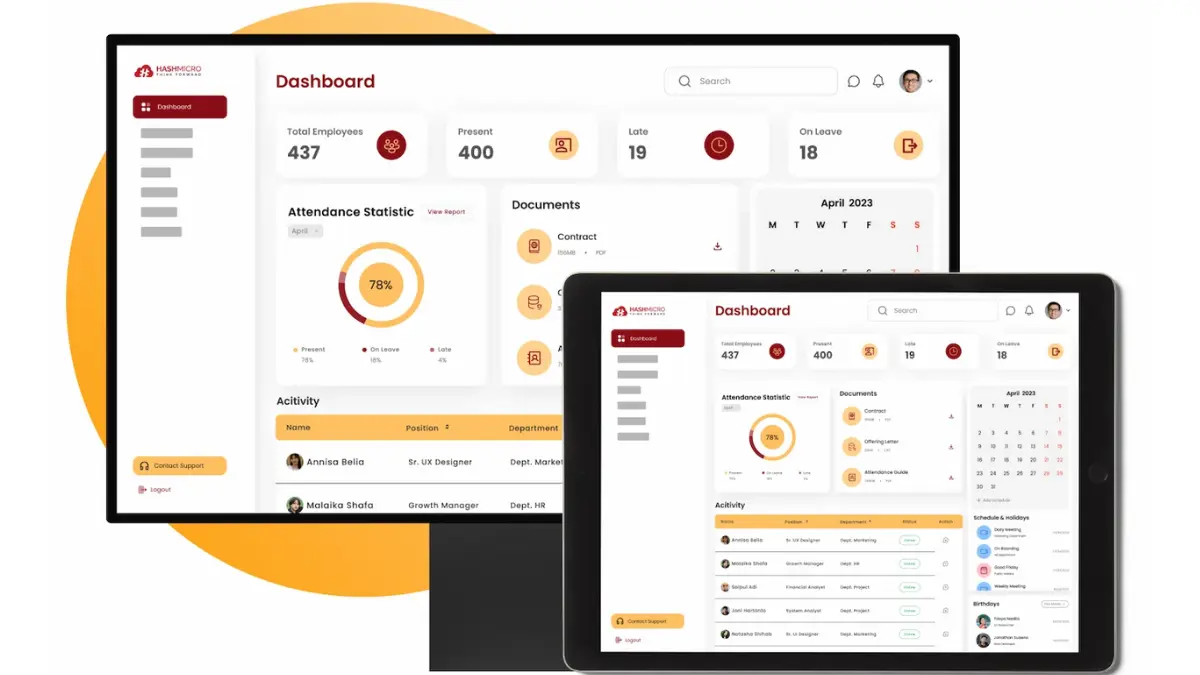Managing payroll is one of a business’s most critical yet challenging tasks. The pressure to get everything right, from calculating salaries to ensuring tax compliance, can feel overwhelming.
Mistakes in manual payroll systems are a common concern—errors in tax calculations, attendance, and leave tracking can quickly lead to financial losses. These mistakes not only affect employee satisfaction but can also create long-term administrative headaches.
According to a McKinsey study, up to 50% of HR tasks in Southeast Asia, including payroll, can be automated to boost efficiency. This shift could save businesses time and money, ensuring a more streamlined approach to payroll management.
Explore the HashMicro Payroll System solution to make payroll management stress-free and efficient. In this article, we will explore how automated payroll systems can not only save time but also improve accuracy and ensure compliance.
Table of Content
Content Lists

Key Takeaways
|
What is a Payroll Management System?
A payroll management system automates tasks like calculating employee salaries and taxes, saving time and reducing errors. This efficiency ensures accurate and timely payments while streamlining businesses’ payroll operations.
Cloud-based payroll systems integrate payroll, attendance, and tax filing, improving financial tracking and reducing administrative tasks. These systems enhance efficiency and ensure compliance with regulations, benefiting businesses of all sizes.
Cloud-based payroll systems offer superior security to manual methods, safeguarding sensitive employee data. Automation frees HR teams from routine tasks, allowing them to focus on strategic initiatives while maintaining compliance and accuracy.
Why is the Payroll System Important?

A payroll system is an essential tool for businesses. It automates and streamlines employee compensation management, ensuring accuracy, compliance, and efficiency across various payroll tasks, which is crucial for maintaining smooth business operations.
- Ensures accurate employee compensation: A payroll system automates salary calculations, deductions, and overtime pay, minimizing manual errors. This ensures employees are paid accurately and on time, boosting trust and morale within the organization.
- Simplifies tax compliance: A payroll system helps businesses comply with government regulations by providing built-in tax calculation features. It automatically generates reports and ensures taxes are filed on time, reducing the risk of penalties.
- Saves time and increases efficiency: Automating payroll processes saves businesses significant time that would otherwise be spent on manual calculations. HR teams can focus on strategic planning and other business-critical tasks instead of administrative work.
- Enhances data security: A reliable payroll system with secure access controls protects sensitive employee data, such as salaries and bank account details. This helps prevent unauthorized access and ensures data confidentiality.
- Improves record-keeping: Payroll systems keep detailed records of employee payments, taxes, and benefits, ensuring transparency and simplifying audits. These records can be easily accessed for accurate reporting and financial management.
- Supports scalability: As businesses grow, managing payroll manually becomes more complex. A payroll system scales with the company, effortlessly handling new employees and more complex payroll structures.
- Facilitates employee benefits management: Integrated with benefits administration, a payroll system helps businesses manage employee perks like health insurance and retirement plans. This ensures employees receive the correct entitlements and benefits on time.
- Customizable features for business needs: Modern payroll systems offer customizable features tailored to specific business requirements, including multi-currency payments and compliance with local laws. This flexibility ensures the system meets unique business needs.
- Reduces administrative costs: Automating payroll reduces the administrative expenses tied to manual processing and error correction. A payroll software solution, such as the Autocount payroll system, makes payroll management more cost-effective for businesses.
- Promotes employee satisfaction: Employees who are paid accurately and on time are more likely to be satisfied and motivated. A reliable payroll system ensures timely payments, which helps foster a positive workplace environment and reduces employee turnover.
Investing in a dependable payroll system, such as a Malaysian payroll system, will streamline payroll tasks, enhance compliance, and enable your business to focus on growth. Companies can maintain an efficient and happy workforce by leveraging the right payroll reporting tools.
Types of Payroll Management Systems

Choosing the right payroll system is crucial in helping businesses run smoothly, stay compliant, and manage employee salaries efficiently. Studies show that an automated payroll system not only boosts productivity but also reduces payroll processing time and improves accuracy, ultimately leading to long-term cost savings.
Below are the main types of payroll systems, each with features tailored to different business needs:
1. Manual payroll systems
Manual payroll systems involve processing payroll using spreadsheets, paper records, or calculators. This approach may be suitable for small businesses with a limited number of employees, but it is highly time-consuming and prone to human error, resulting in inaccurate calculations.
As businesses grow, manual systems become inefficient and harder to scale, making it challenging to keep up with changing tax regulations. Consequently, companies face the risk of non-compliance and delayed payments.
2. Outsourced payroll services
Outsourcing payroll to external service providers enables businesses to delegate the payroll process to experienced professionals. These providers are knowledgeable about tax laws and payroll compliance, ensuring accurate and timely processing.
Outsourcing saves businesses valuable time, enabling internal teams to focus on more critical functions. Additionally, outsourced services offer scalability to accommodate growth and provide access to advanced payroll software without direct investment in the tools.
3. Automated payroll management systems
Automated payroll management systems use software to streamline the entire payroll process, offering automated calculations for wages, taxes, deductions, and benefits. These systems facilitate direct deposits, eliminating the need for physical checks and speeding up payments.
They also automatically handle tax filings and compliance, ensuring the business meets legal requirements. Additionally, automated systems integrate with other business tools like HR software and provide employee self-service portals to access pay stubs and benefits.
4. Cloud-based payroll systems
Cloud-based payroll systems are a more advanced subset of automated systems, offering accessibility from anywhere with an internet connection. These systems receive automatic provider updates, ensuring businesses stay current with the latest features and compliance regulations.
Sensitive payroll data is well-protected with advanced security measures, such as encryption and regular backups. Cloud-based payroll systems are cost-effective, subscription-based, and provide scalability, making them ideal for businesses seeking flexibility and technological advancement, such as the Autocount payroll system.
By understanding the features and benefits of each payroll system, businesses can choose the solution that best suits their needs, improves efficiency, and ensures seamless employee salary processing while maintaining compliance.
The Benefits of a Payroll Management System

A payroll system is essential for businesses to improve accuracy and efficiency by automating complex calculations related to employee salaries, taxes, and deductions. This automation reduces the risk of errors and ensures timely, accurate payments. Below are the key benefits of implementing a payroll system for your company:
1. Automated payroll processing
Automating payroll processing saves significant time by handling complex tasks such as calculating salaries, tax deductions, and generating payslips. Manual payroll processing is often error-prone and time-consuming, but automation eliminates these issues.
This allows HR and accounting teams to focus on more strategic tasks, boosting overall productivity. By using payroll software, businesses can streamline payroll processing and enhance efficiency.
2. Integration with other systems
A payroll system that integrates with other business systems, like accounting or HR software, enhances operational efficiency. This integration synchronizes data across various platforms, eliminating the need for manual data entry and minimizing the risk of errors.
It leads to improved accuracy and consistency across departments. By integrating payroll software such as HashMicro, businesses can further optimize processes and improve their overall system performance.
3. Secure data management
A payroll system ensures the secure storage and management of sensitive employee data, such as financial and personal information. These systems use advanced encryption and access controls to prevent unauthorized access and safeguard data from breaches.
This level of security is crucial to maintaining employee privacy and complying with data protection regulations. Using payroll systems ensures that your business takes the necessary precautions to protect employee and company data.
4. Improved reporting and analytics
Payroll systems have robust reporting and analytics capabilities, allowing businesses to generate detailed insights into labor costs, payroll deductions, and employee attendance. These reports help with financial planning, budgeting, and informed decision-making.
Real-time access to payroll data enables businesses to monitor trends, optimize resource allocation, and strategize for future growth. Payroll reporting tools enhance business planning and provide valuable insights.
5. Minimizes errors
Manual payroll processing is prone to human errors, leading to employee dissatisfaction or even tax non-compliance. A reliable payroll system automates complex calculations, ensuring accuracy and reducing the risk of mistakes.
Many payroll software solutions, including the Autocount payroll system, offer penalty protection in case of tax-related errors, providing an extra layer of security. This minimizes costly errors and promotes employee satisfaction.
Investing in a reliable payroll system allows businesses to ensure compliance, improve data security, and streamline payroll processes, all while boosting productivity and reducing the risk of errors.

Key Features of Payroll System

When selecting the best payroll system for your business, consider the features that will improve efficiency, accuracy, and compliance. The right system can streamline your operations, minimize errors, and ensure all regulations are met.
Here are some key features to look for:
-
Calculation of insurance, taxes, and bank payroll
A reliable payroll system automates the calculation of insurance, taxes, and direct deposits to employee bank accounts. This feature ensures that businesses remain compliant with tax and insurance regulations while reducing the chance of errors.
Automating these processes saves valuable time and ensures accurate payroll processing. With this feature, businesses can ensure timely and correct payments to employees and regulatory authorities.
-
Overtime management is linked with attendance and payroll
Integrating overtime management with attendance tracking and payroll processing is crucial for accurate payroll calculations. This feature allows the system to automatically calculate overtime pay based on actual hours worked, ensuring that employees are fairly compensated.
The process becomes streamlined by linking attendance and payroll, and HR teams can focus on more strategic tasks. It also reduces the risk of errors in overtime calculations, enhancing payroll efficiency.
-
Expense management
A payroll system that integrates an expense management system enables the recording, approval, and reimbursement of employee expenses, such as travel or office supplies. This integration ensures that all employee expenses are processed smoothly, reducing manual tasks and ensuring accurate reimbursement.
It also ensures that businesses maintain accurate financial records by linking expenses directly to payroll. This feature streamlines the reimbursement process and enables businesses to track expenses efficiently.
-
Manage bonuses, allowances, and deductions
An effective payroll system should be able to manage various forms of employee compensation beyond the regular salary, such as bonuses, allowances, and deductions. This feature automatically calculates and distributes additional payments, ensuring that employees are compensated correctly.
It also ensures that any deductions are made accurately and recorded in detail. Businesses can maintain precise compensation records and reduce administrative work by managing these elements.
-
Payroll auditing and error reporting
A key feature of a payroll system is the ability to audit payroll transactions, identify discrepancies, and generate error reports. This helps businesses detect and correct errors early before they become significant issues.
Regular audits improve payroll accuracy and ensure compliance with regulatory standards. This feature also prevents fraud, helping businesses maintain a secure and reliable payroll process.
-
Compensation management
Many payroll systems include features for managing and analyzing compensation data, supporting businesses in developing competitive and fair compensation strategies. This feature helps businesses make informed decisions about salary adjustments, promotions, and employee benefits.
It ensures that compensation remains aligned with industry standards, helping companies stay competitive in the labor market. With these tools, companies can make data-driven decisions about compensation that benefit both the business and its employees.
-
General ledger mapping
The payroll system integrates payroll data with the company’s accounting system, ensuring that payroll transactions are accurately reflected in the general ledger. This feature simplifies updating the ledger by automatically incorporating payroll-related costs, reducing the need for manual entries.
It improves financial reporting by maintaining accurate and up-to-date financial records. General ledger mapping ensures that payroll-related transactions are consistently accounted for, aiding in financial analysis and reporting.
By incorporating these key features, businesses can significantly improve employee salary processing, ensure compliance, and reduce administrative overhead. A comprehensive payroll system like the Autocount offers these features, enabling companies to operate efficiently and remain compliant with tax regulations.
Step by Step: How a Payroll Management System Works
Managing payroll ensures employees are paid accurately and on time, which is crucial for any business. In countries like Malaysia, where payroll regulations are complex, manual processing becomes inefficient and increases the chance of errors.
Manually managing payroll is difficult and exhausting for businesses with a larger workforce. Without proper payroll software, the task becomes overwhelming, and critical details like tax deductions or benefits can be missed.
Automating payroll processes saves businesses time, reduces costs, and minimizes the risk of errors. A well-integrated payroll system helps businesses comply with regulations and allows them to focus on strategic growth rather than payroll management challenges.
Three Stages of Payroll Process: A Step-by-Step Guide

Understanding the stages of the payroll process is essential for businesses to streamline operations and ensure efficiency. By breaking down the process into three key stages, companies can better grasp how a payroll system simplifies each step and enhances accuracy.
Let’s explore these stages and how a reliable payroll system can optimize payroll management:
Stage 1: Pre-payroll activities
The pre-payroll stage is critical for ensuring that payroll processing runs smoothly. It includes defining clear payroll policies, gathering accurate inputs such as attendance and tax declarations, and validating this data to ensure completeness and correctness, which is essential for precise payroll calculations.
Stage 2: Actual payroll process
Calculations are performed during the actual payroll stage, and payouts are determined based on the validated data. The payroll software automatically calculates salaries, taxes, and deductions, ensuring employees receive accurate compensation without delays.
Automating these calculations reduces the risk of manual errors and ensures timely payouts, maintaining employee satisfaction and trust.
Stage 3: Post-payroll process
The post-payroll stage focuses on ensuring statutory compliance, accounting, and reporting to meet legal requirements. This stage involves making necessary tax payments, accurately recording payroll expenses for financial reporting, and distributing salaries via approved bank transfers.
Detailed payroll reporting tools enable businesses to analyze payroll trends, ensure compliance, and inform more informed decision-making. They also simplify audits and enhance transparency.
By following these step-by-step processes, businesses can ensure an accurate, compliant, and efficient payroll management system.
Main Approaches to Payroll Management System
Choosing the right payroll system is vital for businesses to ensure that employee compensation is accurate, compliant, and processed efficiently. Different approaches to payroll management offer various advantages based on a company’s size, complexity, and operational needs.
Here are the main approaches to payroll management systems, each providing distinct benefits:
1. Manual payroll management
Manual payroll management involves calculating employee salaries, taxes, and deductions by hand or using spreadsheets. While this method may work for small businesses with few employees, it is time-consuming and prone to human error.
Payroll processing requires careful attention to detail to ensure accuracy, but the risk of mistakes remains high. This approach can also become increasingly inefficient as the business grows, requiring more resources and time.
2. In-house payroll software
In-house payroll software automates the payroll process within the company’s systems, including salary calculations and compliance. This method gives businesses full control over payroll data, allowing for customization and internal oversight.
However, it requires IT resources for system maintenance, updates, and security, which can add additional costs and complexity. Companies must have the technical expertise to manage and update the system.
3. Cloud-based payroll system
Cloud-based payroll systems provide businesses with secure, real-time online access to payroll data from any location. These scalable and convenient systems make them ideal for companies with remote teams or multiple locations.
Cloud systems reduce the need for on-premises infrastructure and maintenance, providing a flexible solution that can grow with the business. Businesses use cloud-based payroll solutions to ensure continuous updates and improvements to meet regulatory changes.
4. Outsourced payroll services
Outsourcing payroll involves delegating all payroll calculations, tax filings, and compliance tasks to a third-party service provider. This method saves businesses valuable time and ensures accurate, timely payroll processing by professionals.
However, sensitive employee data is managed externally, which may raise concerns about data security and privacy. Outsourcing payroll is ideal for businesses looking to focus on core operations while leaving payroll management to experts.
5. Hybrid payroll system
A hybrid payroll system combines internal payroll processes with external service providers to enhance flexibility and efficiency. This approach allows businesses to maintain control over key tasks like salary calculations and deductions, while leveraging the expertise of third-party providers for more complex payroll operations.
It offers a balanced solution that ensures accuracy and compliance while reducing administrative burden. Companies can adjust the level of outsourcing based on their specific needs and operational goals.
6. Integrated payroll system with HR tools
An integrated payroll system with HR tools combines payroll management with other functions, such as attendance tracking, benefits management, and employee records. This integration streamlines operations, providing a comprehensive view of employee management and ensuring consistency across HR processes.
By connecting payroll data with HR systems, businesses can reduce manual input and avoid errors caused by disjointed systems. This approach enhances efficiency and improves decision-making by giving a more complete view of employee compensation and performance.
Each payroll management approach offers unique benefits tailored to different business needs. Choosing the right payroll system, whether in-house payroll software, a cloud-based payroll system, or outsourced payroll services, will depend on the company’s size, resources, and goals.
HashMicro as the Payroll System Solution for Your Malaysian Business

HashMicro stands out as one of Southeast Asia’s top Payroll System providers, renowned for its reliability and advanced technology. With its extensive experience in Enterprise Resource Planning (ERP), HashMicro offers a comprehensive suite of services designed to meet the unique needs and expectations of businesses in Malaysia.
The software’s multiple modules offer integrated business management, with the payroll module being particularly valuable for Human Resources (HR) departments. HashMicro’s payroll system simplifies complex payroll processes, saving time and minimizing the risk of errors, and reducing administrative burdens for businesses of all sizes.
As a leading HRIS software, HashMicro helps businesses enhance operational efficiency by streamlining payroll management in Malaysia. Its key features include automated salary calculations, time and attendance tracking, and seamless compliance with local laws and tax regulations.
HashMicro’s payroll system consists of a range of superior features, such as:
- Fully Localized Payroll with Accurate Tax Calculation: The payroll system offers fully localized payroll solutions, ensuring compliance with Malaysian tax laws and regulations. Automated tax calculations reduce the risk of errors in deductions and contributions, ensuring your business stays compliant with local requirements and avoids penalties.
- Employee Training Management: HashMicro’s software features a module to manage employee training programs, enabling businesses to track and optimize employee development. HR departments can plan, execute, and monitor training activities to improve employee performance and align skills with organizational goals.
- Comprehensive Reporting on Payroll, Leave, Expenses, Overtime, and Attendance: With detailed reporting capabilities, HashMicro provides insights into payroll, leave, expenses, overtime, and attendance data. These reports enable management to make informed decisions on budgeting, performance evaluations, and strategic planning, while enhancing transparency and operational accuracy.
- Dynamic Roster and Employee Scheduling: The software’s roster and scheduling feature enables flexible and dynamic employee working hours and shift management. It ensures that employee schedules are well-organized, optimizing productivity and minimizing conflicts, which leads to better resource allocation and smoother operations.
These features make HashMicro’s Human Resource Information System an effective solution for companies in Malaysia seeking to enhance payroll accuracy, improve efficiency, and ensure compliance with local regulations. Additionally, the system can be customized to meet specific business needs and integrates seamlessly with other business systems.
Conclusion
Modern payroll systems are now a necessity for any business in Malaysia. They help reduce errors, save valuable time, and ensure that employees are paid accurately and on time. Automating complex tasks enables businesses to maintain compliance, streamline payroll management, and enhance overall operational efficiency.
In addition to enhancing payroll management, HashMicro’s HRM software provides a comprehensive all-in-one solution for HR management, encompassing employee data administration, recruitment, and talent management.
Take the next step towards improving your payroll and HR processes – schedule a free demo today to discover how HashMicro’s HRIS software can simplify your payroll management and overall HR operations!




































